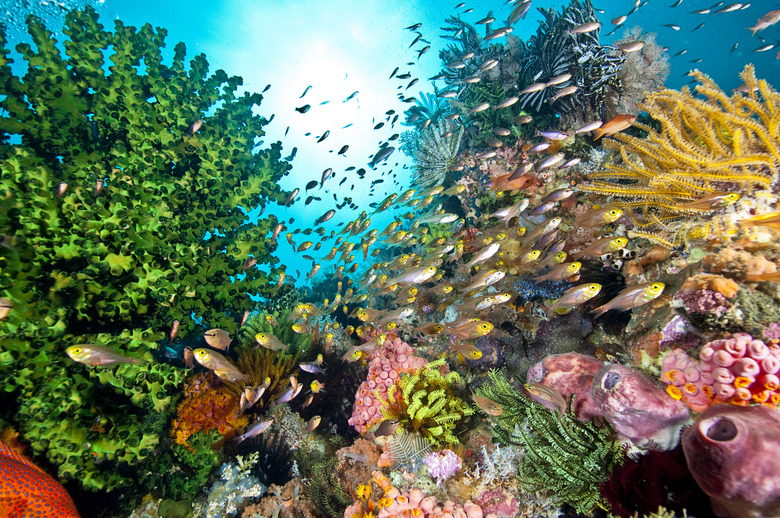What Is An Ecosystem Made Up Of?
An ecosystem is composed of three primary components. These consist of living organisms and their material remains, also referred to as organic or biotic factors; their physical environment, which includes rocks and minerals, sunlight, atmosphere, water and other non-organic abiotic factors; and the interrelationships between them within a given area. An ecosystem can exist in many scales, from a single spoonful of soil to vast systems that cover continents. Common examples of ecosystems include forests, grasslands and deserts in terrestrial areas; rivers, lakes and wetlands in freshwater areas; and estuaries, seagrass meadows and coral reefs in the marine environment.
Ecosystem Processes
Ecosystem Processes
There are four ecosystem processes that occur within all environments. These are the water cycle, the mineral cycle, energy flow and community dynamics. These systems are interrelated, and changes in one will invariably lead to changes in the other. Maximizing biodiversity, the capture of solar energy, and the availability of water and minerals within an ecosystem will maximize the productivity, health and resilience of that system.
Abiotic (Nonliving) Elements
Abiotic (Nonliving) Elements
All ecosystems contain abiotic (nonliving) factors, which can also be referred to as inorganic components. Examples of abiotic factors within an ecosystem include air, sunlight, soil, water and temperature. These components are necessary to support the presence of all living ecosystem components.
Water is essential for the functioning of cellular processes, and all life on Earth requires water to exist and survive. Sunlight is the primary source of energy for all ecosystems, with the exception of deep-sea hydrothermal vent ecosystems.
The atmosphere contains important gases, most notably oxygen, which is required during the process of cellular respiration. Soils are composed of both abiotic and biotic elements, with rocks, sand and minerals providing minerals and a growing substrate for plants and a habitat for soil organisms.
Biotic (Living) Elements
Biotic (Living) Elements
Biotic, or organic, factors, consist of all living organisms and their physical remains after death. There are several kingdoms of living organisms: plants, animals, fungi, protists, bacteria and archaea (a type of primitive bacteria).
Once an organism dies, its is still considered a biotic factor within an ecosystem and plays an important role in community dynamics as it breaks down, or decomposes. Once it has fully decomposed, its elements are considered to have reverted to an abiotic state.
Biotic organisms in the ecosystem can be divided into two main types: producers and consumers.
Producers
Producers
Producers form the base of all energy flow within an ecosystem by capturing light or chemical energy and transforming it into a form that can be used in cellular processes. The majority of producers, including plants, algae and cyanobacteria, use photosynthesis to capture sunlight and convert it into sugars to be used an as energy source.
Another, much rarer, form of energy capture is chemosynthesis. This is carried out by certain types of bacteria, which use dissolved chemicals in the water to produce energy, instead of using sunlight which may not be available.
Generally speaking, producers obtain all of their energy and nutritional requirements from abiotic sources such as soil, water and air. However, there are several exceptions. Some plant species, such as mistletoe, are parasitic and gain nutrients from the trees and shrubs that they grow upon. Carnivorous plants, such as Venus flytraps, pitcher plants and sundews, often grow in nutrient-poor environments and supplement their nutritional intake by capturing and consuming insects and other small animals.
Consumers
Consumers
After producers, all other organisms within an ecosystem are consumers. These range from mammals, birds and reptiles to insects, worms, micro-organisms and fungi. Consumers are defined by the requirement to consume other biotic elements to supply their energy and nutritional requirements, although many will also consume abiotic elements (such as mineral-rich soil) to supplement their diet.
There are several different types of consumers. Herbivores, which include elephants, bison and rabbits, are organisms that obtain the majority of their energy from producers (plants). Carnivores such as tigers, wolves and hawks consume other animals for their sustenance, while omnivores, including bears and baboons, regularly eat both animals and plants for nutrition. Scavengers such as vultures and hyenas are animals that eat dead organisms they find that have been killed by another cause.
Another class of consumer are detritivores (decomposer organisms). They consume organisms that are already dead and can range from slugs and earthworms to millipedes, pillbugs and microscopic soil creatures. Fungi – such as mushrooms, yeasts and molds – are also detritivores and obtain their energy from decomposing animal and plant material. Decomposers play an important role in the ecosystem by releasing nutrients back into the environment that can then be used by producers, forming an essential link in the mineral cycle.
Cite This Article
MLA
Michelle, Meg. "What Is An Ecosystem Made Up Of?" sciencing.com, https://www.sciencing.com/ecosystem-made-up-of-6574/. 30 September 2021.
APA
Michelle, Meg. (2021, September 30). What Is An Ecosystem Made Up Of?. sciencing.com. Retrieved from https://www.sciencing.com/ecosystem-made-up-of-6574/
Chicago
Michelle, Meg. What Is An Ecosystem Made Up Of? last modified August 30, 2022. https://www.sciencing.com/ecosystem-made-up-of-6574/
